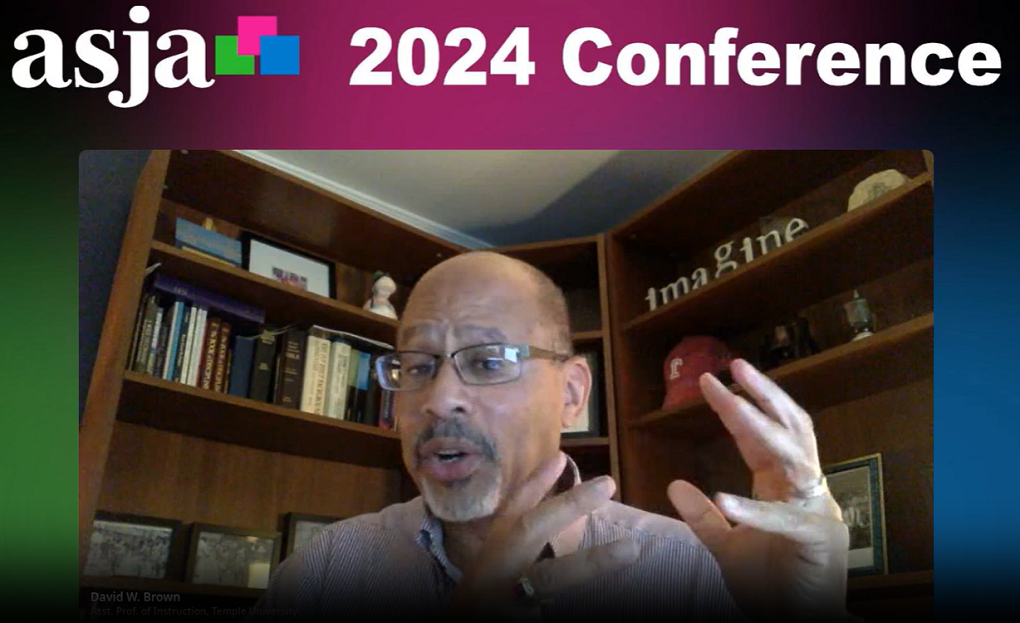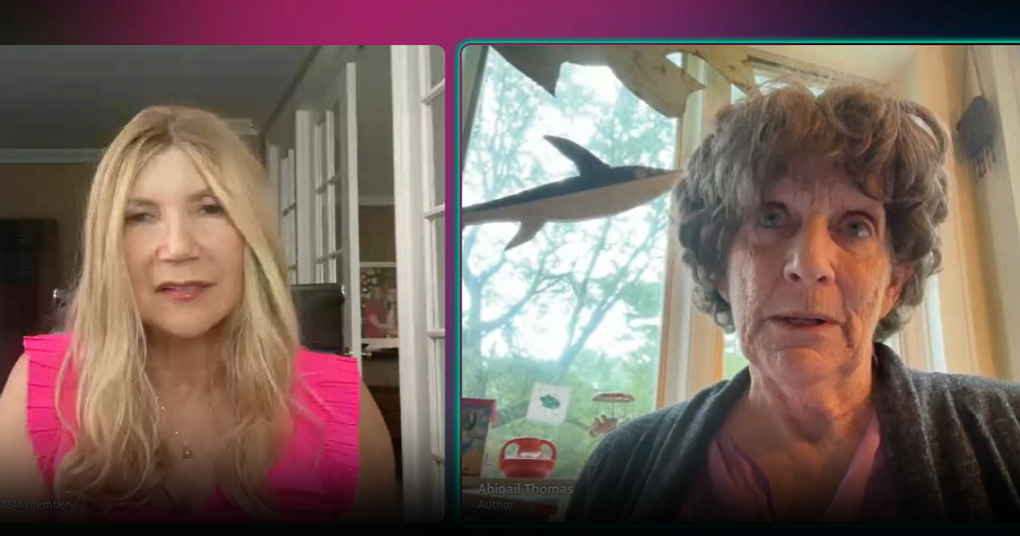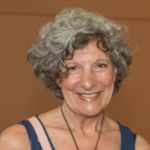
Who lives, who dies, who tells your story?
Two keynote speakers on the final day of the 2024 ASJA conference had the same answer to the famous line from Hamilton.
If it’s your story, you’re the only one who can tell it, according to David W. Brown, a Philadelphia writer, communicator, advocate, and associate at Temple University.
Brown’s story started when he was 16 growing up in West Philly. He was wrongly targeted in a drive-by shooting but the gun misfired. It scared him off the streets. “I didn’t want to be another statistic, another Black boy dead on the street,” he said. The only tool he had to process what had happened was writing.
It started him on a path that eventually led to a career as a reporter, book author, consultant, and advertising and PR agency owner, among other things, and toward a life-long calling to be an advocate.
“I’ve been blessed to have writing to connect to people,” Brown said.
If you write for a paycheck – and if you freelance you probably do – you also have stories that live inside you that have to come out. “It’s a force that we cannot contain,” Brown said.
Carving out time and head space for personal writing can be hard. Brown said he writes on parallel tracks – switching between personal projects and deadline-driven, assigned writing work.
According to Brown, it’s important at this moment in time, on the eve of what he referred to as the “election of our generation” to be authentic, true to who you are, and share what you see as important.
“I’ve done a lot of reading and speaking about times that are difficult,” he said. “For a lot of us, if we have something to say, we have to say it. I think my life was spared for a reason, and because of that reason I can’t be silent when our communities are threatened and racism is prevalent. I’m not special, but if I have a voice, I need to use it.”
Through the Side Door
In Hamilton, Lin Manuel Miranda used Alexander Hamilton’s life to share the nation’s origin story, including the internecine conflicts between its early leaders that civics classes might skip.
Memoirist and author Abigail Thomas advocates using the same method of “sliding in through the side door” to write about trauma, heartbreak, and other topics that could be hard to tackle head on.
Thomas, who spoke in a fireside chat with ASJA member and author of Writing That Gets Noticed Estelle Erasmus to close out the conference, said a side door could be a writing prompt, a glimmer of an idea, or happenstance. It could be quirky, funny, or provocative. When Thomas’ daughter was diagnosed with breast cancer, Thomas didn’t think she could continue working on the book she was writing at the time. Then Thomas’ dog ran out the house’s doggie door with her daughter’s cancer wig. “That was my side door, and then I could write about the cancer,” she said.

Thomas was kicked out of college after getting pregnant, and didn’t publish until she was 50. She wanted to be a writer all along, but thought writers “had deep thoughts and were smarter and had more interesting lives.”
When she finally started, Thomas was inspired by a writing teacher’s instruction to approach the craft with a beginner’s mindset, embracing possibility and practice. It’s like making pie crust, she said. The first 10 you make are awful. “But the eleventh might be better. And that worked.”
Thomas shared other tips for writing memoir and other first-person writing:
- Start in the middle. From there, you can move backward or forward and keep going back and forth.
- For writers’ block, try primal whine therapy. Complain how hard it is – but do it in writing. You may end up writing about the thing you’re complaining about.
- Focus on writing not how to get published. If you’re writing memoir, write for yourself first. Make it honest.
- Whittle things down. Thomas spends more time distilling than writing. “It takes me time to get it short,” she said. “The thing about memoir is it’s the truth and doesn’t need a lot of furniture.”
Journalism By the Numbers
Data is a different way to tell a story, and according to Sept. 25 conference keynote speaker Peter Shankman, is becoming a must-have journalism and storytelling tool.
Data-based journalism may sound intimidating, and data journalists Kae Petrin and Marina Villeneuve, who spoke at a session devoted to the subject, are spreadsheet experts, software coders, and data visualization pros.
At its essence, data journalism is a set of tools for figuring out the best way to tell a story, said Petrin, a data and graphics reporter for Chalkbeat, a nonprofit news site covering education run by Civic News Company, and president and cofounder of the Trans Journalists Association.
Getting started can be as simple as understanding what public records or datasets are available on a particular topic and how to use them. Common sources are government or financial records, demographic information, police calls, polls, and research studies. Common places to look for data sources are local, state, and federal agencies, research institutions, and open source journalism resources such as those created by ProPublica and Investigative Reporters and Editors.
When working on a data-based project, Petrin encourages writers to “interview” the data to assess how the information was collected, when, why and by whom.
Villeneuve, an investigative journalist who covers education for The Hechinger Report, spent six years covering New York state politics. She walked conference goers through the process of putting raw government data – in this case campaign donations – through a spreadsheet and pivot table to learn what trends could be locked inside the information.
Petrin and Villeneuve recommend taking classes such as those offered by IRE or Columbia University’s Lede Program, both of which offer financial aid to help defray costs. More resources and training opportunities are listed in their presentation, which is available here.
Client Connections
The 2024 conference sessions are over, but Client Connections is still underway. The turnout for Client Connections was inspiring, with more than 60 editors, agents, and other clients signing up for one-on-one meetings with ASJA professional members.
This year, 80% of ASJA professional members who signed up for Client Connections got a meeting with their first pick of a client, close to 98% got their first or second choice, and every single person got their first, second, or third choice.
A big thank you for ASJA Executive Director Dirk Lammers and the Client Connections 2024 cochairs Cari Shane, Richard Eisenberg, and KJ Bannan for the hard work they put into making the event a success. Thanks also to the Client Connections 2024 committee for their behind-the-scenes labors.
If you get assignments from Client Connections meetings, we’d love to hear about them. Please share on the ASJA Facebook page or send a note to the ASJA office, asjaoffice@asja.org.
Client Connections will return in person as part of the 2025 ASJA conference in New York, Feb. 24-26.
Share Your Feedback
Help us make future conferences even better by sharing what you thought of the event. For starters, take the post-conference survey that will arrive in your inbox in coming days. It only takes a few minutes to fill out, and will give us the feedback that we need to make conference keynotes, educational sessions, Client Connections, and other networking opportunities even better in the future.
You can also leave comments on the ASJA Facebook page.
Thanks to the Conference Planning Team and Volunteers
Heart-felt thanks go out to all the volunteers who made the conference possible:
- Dirk Lammers and Angela Lammers and Cetera Services, ASJA’s management team
- Emily Paulsen, ASJA president and 2024 conference chair
- Emily Dalamangas, conference cochair
- Kristine Hansen and Jen Billock, journalism track cochairs
- Sue Shapiro, books track chair
- Kimberly Yavorski and Karon Warren, content marketing writing track chairs
- Darcy Lewis, ASJA vice president
- Rita Colorito, Stacey Freed, and Holly Rizzuto Palker, conference committee members
- Merlisa Corbett, ASJA social media coordinator, and Holly Rizzuto Palker, social media volunteer
- Holly Simmons, ASJA Weekly newsletter editor
- Fiona Young Brown, ASJA Confidential blog editor
- Olga Torres, Rich Eisenberg, and Rita Colorito, volunteer session monitors
Michelle Rafter is a Portland Oregon, business ghostwriter, ASJA’s publications chair, and part of the 2024-2025 conference planning committee.

